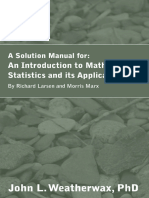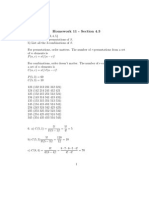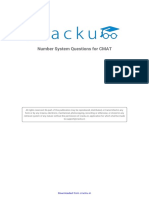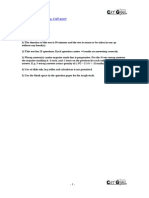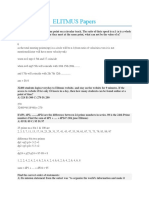TCS Sample Questions
TCS Sample Questions
Uploaded by
AshokCopyright:
Available Formats
TCS Sample Questions
TCS Sample Questions
Uploaded by
AshokOriginal Description:
Original Title
Copyright
Available Formats
Share this document
Did you find this document useful?
Is this content inappropriate?
Copyright:
Available Formats
TCS Sample Questions
TCS Sample Questions
Uploaded by
AshokCopyright:
Available Formats
TNQT Digital Sample Questions
Scope:
TCS Confidential Page | 1
Advanced Quantitative Aptitude:
1. Of 60 students in a class, anyone who has chosen to study Maths elects to study Physics as well. But no student
studies Maths and Chemistry, and 16 study Physics and Chemistry. Each of the students elect for at least one of the
three subjects and the number of people who study exactly one of the three is more than the number who do more
than one of the three. What are the maximum and minimum number of students who could have studied only
Chemistry?
Option 1 : 44, 0
Option 2 : 38,2
Option 3 : 28,0
Option 4 : 40,0
2. The average score in an examination of 10 students of a class is 60. If the scores of the top five students are not
considered, the average score of the remaining students falls by 5. The pass mark was 40 and the maximum mark
was 100. It is also known that none of the students failed. If each of the top five scorers had distinct integral scores
and each of their scores are greater than any of the remaining scores, the maximum possible score of the topper is
Option 1 : 95
Option 2 : 100
Option 3 : 87
Option 4 : 99
3. 3L of milk are drawn from a container containing 30L of milk. It is replaced by water and the process is repeated 2
times. What is the ratio of milk to water at the end?
Option 1 : 729 / 271
Option 2 : 2187/100
Option 3 : 81/ 19
Option 4 : 743/229
4. a, b, c are real numbers in a Geometric Progression (G.P.) such that |a + b + c| = 15. The median of these three
terms is a, and b = 10. If a > c, what is the product of the first 4 terms of this G.P.?
Option 1 : 40,000
Option 2 : 32,000
Option 3 : 8,000
Option 4 : 2,500
5. B takes 12 more hours than A to complete a task. If they work together, they take 16 fewer hours than B would
take to complete the task. How long will it take A and B together to complete a task twice as difficult as the first one?
Option 1 : 16 hours
Option 2 : 12 hours
Option 3 : 14 hours
Option 4 : 8 hours
TCS Confidential Page | 2
6. A number when divided by 18 leaves a remainder 7. The same number when divided by 12 leaves a remainder n.
How many values can n take?
Option 1 : 1
Option 2 : 2
Option 3 : 0
Option 4 : 3
7. In how many ways can we stack n different coins so that two particular coins are not adjacent to each other? [
Note that m! = (1)(2)(3)...(m) ]
Option 1 : (n − 2) * (n − 1) !
Option 2 : (n − 2) !
Option 3 : (n − 1) * (n − 1) !
Option 4 : (n) * (n − 2) !
8. For how many integer values does the following inequality hold good?
(x + 2) (x + 4) (x + 6)...(x + 100) < 0
9. Consider the set S = {8, 5, 1, 13, 34, 3, 21, 2}. Akshay lists all the two element subsets of S and takes the larger of
the elements in each set. If he sums all these numbers, the sum he will obtain is __________
10.Set P comprises all positive multiples of 4 less than 500. Set Q comprises all positive odd multiples of 7 less than
500, Set R comprises all positive multiples of 6 less than 500. How many elements are present in P ∪ Q ∪ R
?___________
Advanced Programming Logic :
1. Which one of the following algorithm design techniques is used in finding all pairs of shortest distances in a graph?
Option 1 : Dynamic programming
Option 2 : Backtracking
Option 3 : Greedy
Option 4 : Divide & Conquer
2. Eesha wrote the below program . Comment about the correctness of the program.
#include <stdio.h>
int main ()
{
printf("%f\n", sum(10.1, 5.2));
return 0;
}
sum(a, b)
{
return (a+b);
}
TCS Confidential Page | 3
Option 1 : Problem with return type and parameter types in function definition
Option 2 : conio.h not included
Option 3 : Command line parameters for main() not declared
Option 4 : There are no bugs in this program
3. What is the time complexity of following function fun()? Assume that log(x) returns log value in base 2.
void fun()
{
int i, j;
for (i=1; i<=n; i++)
for (j=1; j<=log(i); j++)
printf("hello"); }
}
Option 1 : Θ(nLogn)
Option 2 : Θ(n)
Option 3 : Θ(n^2)
Option 4 : Θ(n^2(Logn))
4. Consider the below code for insertion sort. The initial value of the array elements is given in the program as part
of array initialisation. What will be the value of the array elements at the beginning of 6th iteration .
#include <stdio.h>
#define N 10
int main()
{
int c, d, t;
int arr[N]={60,10,90,15,50,80,40,100,4,2};
for (c = 1 ; c <= N - 1; c++)
{
d = c;
while ( d > 0 && arr[d-1] > arr[d])
{
t = arr[d];
arr[d] = arr[d-1];
arr[d-1] = t;
d--;
}
}
return 0;
}
Option 1 : 10 15 50 60 80 90 40 100 4 2
Option 2 : 10 15 50 60 90 80 40 100 4 2
Option 3 : 10 15 40 50 60 80 90 100 4 2
Option 4 : 10 15 60 90 50 80 40 100 4 2
5. A binary search tree is generated by inserting in order the following integers: 50, 15, 62, 5, 20, 58, 91,
3, 8, 37, 60, 24. The number of nodes in the left subtree is ___________
Advanced Coding:
TCS Confidential Page | 4
Problem Statement : Card Shuffle
You have 100 cards, numbered 1 to 100. You distribute them into k piles and collect back the piles in order. For
example, if you distribute them into 4 piles, then the first pile will contain the cards numbered 1, 5, 9, … and the
4th pile will contain the cards numbered 4, 8, 12, …. While collecting back the cards you collect first the last pile,
flip it bottom to top, then take the third pile, flip it bottom to top and put the cards on top of the 4th pile and so
on. Next round, you distribute the cards into another set of piles and collect in the same manner (last pile first
and first pile last).
If we have 10 cards, and put them into 2 piles, the order of the cards in the piles (top to bottom) would be
9, 7, 5, 3, 1 and 10, 8, 6, 4, 2
We flip the piles to get the order
1, 3, 5, 7, 9 and 2, 4, 6, 8, 10
We put second pile at the bottom and first on top of it to get the deck
1, 3, 5, 7, 9, 2, 4, 6, 8, 10
Given the number of rounds (m), number of piles in each round (ki), you need to write a program to find the Nth
card from the top at the end of the final round.
Input
The input consists of a single line of (m+2) comma separated integers.
The first number is m, the number of rounds. The next m numbers are ki which represent the number of piles in
each round.
The last number in the input is N, the position in the final pile whose value is to be determined.
Output
One integer representing the Nth card after all rounds have been played.
Constraints
Number of rounds <= 10, number of piles in each round <= 13.
Example 1
Input
2, 2, 2, 4
Output
13
Explanation
m = 2, k1 = 2, k2 = 2 and N = 4.
We have two rounds. The first round has two piles. At the end of the round, the deck is in the following order:
1, 3, 5, …, 99, 2, 4, 6, …, 100
The next round also has 2 piles and after the second round, the cards are in the order
1, 5, 9, 13, ….
The fourth card from the top has number 13.
Example 2
Input
3, 2, 2, 3, 2
Output
13
Explanation
m = 3, k1 = 2, k2 = 2, k3 = 3 and N = 2.
After the second round, the cards are in the order
1, 5, 9, 13, …
The third round has 3 piles. Thus after this round the cards will be in the order
1, 13, ….
Second card is 13.
TCS Confidential Page | 5
You might also like
- ATI TEAS Calculation Workbook: 300 Questions to Prepare for the TEAS (2024 Edition)From EverandATI TEAS Calculation Workbook: 300 Questions to Prepare for the TEAS (2024 Edition)No ratings yet
- Iquanta Quant Formulae EbookDocument59 pagesIquanta Quant Formulae Ebookonha100% (1)
- Drives In001 en PDocument124 pagesDrives In001 en PjosethompsonNo ratings yet
- Assessment TaskDocument11 pagesAssessment TasktdmoloiNo ratings yet
- Iquanta CAT Quant Formula Book.Document59 pagesIquanta CAT Quant Formula Book.Ashish DeshmukhNo ratings yet
- Number SystemDocument53 pagesNumber Systemsingh11_amanNo ratings yet
- Study GuideDocument20 pagesStudy GuideNo Al Prian100% (1)
- Samplechapter CountingprinciplesDocument151 pagesSamplechapter CountingprinciplesbmandarNo ratings yet
- Weatherwax, John - A Solution Manual For An Introduction To Mathematical Statistics and Its Applications by Richard Larsen and Morris Marx (2017)Document335 pagesWeatherwax, John - A Solution Manual For An Introduction To Mathematical Statistics and Its Applications by Richard Larsen and Morris Marx (2017)mupo528No ratings yet
- Ath em Ati CS: L.K .SH Arm ADocument6 pagesAth em Ati CS: L.K .SH Arm APremNo ratings yet
- Number SystemDocument73 pagesNumber SystemSahithya Honey100% (1)
- Qqad - 2007Document89 pagesQqad - 2007dinesh_kkNo ratings yet
- Solutions of DPM 27Document7 pagesSolutions of DPM 27AshishAmitavNo ratings yet
- Basic Number Theory 2017Document38 pagesBasic Number Theory 2017bhushan patil100% (1)
- Mtap 1st YearDocument7 pagesMtap 1st YearNorman SernaNo ratings yet
- Quantitative Aptitude HandbookDocument176 pagesQuantitative Aptitude HandbookNishant Kumar0% (1)
- Permutations & Combinations Exercise 1 (C)Document4 pagesPermutations & Combinations Exercise 1 (C)Yash ShanbhagNo ratings yet
- ExamDocument20 pagesExamJohn HenryNo ratings yet
- IIFT Entrance Test January 11, 2004: Total Number of Questions Total Time The Marking SchemeDocument0 pagesIIFT Entrance Test January 11, 2004: Total Number of Questions Total Time The Marking SchemeSundeep SinghNo ratings yet
- Fundamental Principles of CountingDocument39 pagesFundamental Principles of CountingOriola KolawoleNo ratings yet
- ProbabilityDocument5 pagesProbabilityIshita SinghNo ratings yet
- Unti We YhbDocument5 pagesUnti We YhbK DhanushNo ratings yet
- 2015 Bull Mock CAT - 18Document52 pages2015 Bull Mock CAT - 18Akshay BabbarNo ratings yet
- Numbers Dec 2012Document8 pagesNumbers Dec 2012PVenkataPuneethhNo ratings yet
- WiproDocument20 pagesWiproMuthu ManiNo ratings yet
- 25 Questions: O C E A N 1 5 9 7 2Document17 pages25 Questions: O C E A N 1 5 9 7 2dharmendraNo ratings yet
- Gmat Review of Wrong questions in Mock examDocument9 pagesGmat Review of Wrong questions in Mock examboscoNo ratings yet
- New Microsoft Office Word DocumentDocument14 pagesNew Microsoft Office Word DocumentSameer SalamNo ratings yet
- Homework 11 - Section 4.3: P (N, R) N!/ (N R) !Document7 pagesHomework 11 - Section 4.3: P (N, R) N!/ (N R) !shivambarcaNo ratings yet
- Class 6th MathsDocument21 pagesClass 6th MathsnehalandethNo ratings yet
- Tcs Code Vita Questions Batch 2Document18 pagesTcs Code Vita Questions Batch 2Deborah Mohan0% (2)
- Number System Questions For CMATDocument11 pagesNumber System Questions For CMATPiyuNo ratings yet
- GAT A Formula ListDocument22 pagesGAT A Formula ListMuhammadBilalMughal100% (3)
- STEMS2023-CS-CategoryADocument6 pagesSTEMS2023-CS-CategoryADr. Kamal AgrawalNo ratings yet
- Instructions:: QQAD, Practice Test 4: CAT 2007Document11 pagesInstructions:: QQAD, Practice Test 4: CAT 2007Abhishek2009GWUNo ratings yet
- CAT ArithmeticDocument8 pagesCAT ArithmeticDeepakKattimani100% (1)
- Tcs NQT Coding QuestionsDocument5 pagesTcs NQT Coding Questionscrazyfact1320No ratings yet
- Elitmus PapersDocument21 pagesElitmus Papersanon_879320987No ratings yet
- AlgorithmComplexityCA CorrectionDocument4 pagesAlgorithmComplexityCA CorrectionBryce NanaNo ratings yet
- Bt0069 Smu Discrete MathematicsDocument268 pagesBt0069 Smu Discrete MathematicsSmruti Ranjan BeheraNo ratings yet
- Zoho Round 2 Question SetDocument38 pagesZoho Round 2 Question SetFree Fire Tamil100% (3)
- Counting TechniquesDocument30 pagesCounting TechniquesathaliumarieNo ratings yet
- GMAT MATH Tough ProblemsDocument51 pagesGMAT MATH Tough Problemsapi-3822924100% (2)
- NUMBERS - PPT Gen Aptitude - 1st Yr SRMDocument17 pagesNUMBERS - PPT Gen Aptitude - 1st Yr SRMANISH PATIL (RA2111029010064)No ratings yet
- Exam1 s15 SolDocument10 pagesExam1 s15 SolVũ Quốc NgọcNo ratings yet
- 2013 12 SP Mathematics 05Document30 pages2013 12 SP Mathematics 05Akanksha Yash KathuriaNo ratings yet
- PermutationDocument5 pagesPermutationrjNo ratings yet
- Mathschallenge 1 Star PDFDocument127 pagesMathschallenge 1 Star PDFSushma RaniNo ratings yet
- GCSE Mathematics Numerical Crosswords Foundation Written for the GCSE 9-1 CourseFrom EverandGCSE Mathematics Numerical Crosswords Foundation Written for the GCSE 9-1 CourseNo ratings yet
- How to Prepare for AMC10: Problem Solving and SkillFrom EverandHow to Prepare for AMC10: Problem Solving and SkillRating: 5 out of 5 stars5/5 (1)
- Matrices with MATLAB (Taken from "MATLAB for Beginners: A Gentle Approach")From EverandMatrices with MATLAB (Taken from "MATLAB for Beginners: A Gentle Approach")Rating: 3 out of 5 stars3/5 (4)
- Master Fundamental Concepts of Math Olympiad: Maths, #1From EverandMaster Fundamental Concepts of Math Olympiad: Maths, #1No ratings yet
- GCSE Mathematics Numerical Crosswords Higher Tier Written for the GCSE 9-1 CourseFrom EverandGCSE Mathematics Numerical Crosswords Higher Tier Written for the GCSE 9-1 CourseNo ratings yet
- Question Text: Correct 1 Points Out of 1Document4 pagesQuestion Text: Correct 1 Points Out of 1gurungeNo ratings yet
- 70 Top ITIL Interview Questions and AnswersDocument12 pages70 Top ITIL Interview Questions and Answersshams_naaz67% (3)
- SeminorreportDocument19 pagesSeminorreportFiroz AnsariNo ratings yet
- Dunning Procedure in SAP S - 4HANADocument91 pagesDunning Procedure in SAP S - 4HANAmohammad.khaseem39No ratings yet
- IT543 RubricsDocument12 pagesIT543 RubricsFahad IftkharNo ratings yet
- Online Gaming Addiction in Children andDocument43 pagesOnline Gaming Addiction in Children andjelly turcoNo ratings yet
- Free Scrum Product Owner I (PSPO I) Practice Assessment - TheScrumMaster - Co.ukDocument32 pagesFree Scrum Product Owner I (PSPO I) Practice Assessment - TheScrumMaster - Co.ukAlin-Iustinian Toderita100% (1)
- TTT PDFDocument250 pagesTTT PDFCST A69 Trisha NandyNo ratings yet
- Aim Vm-III Pro (1500-12) 1.5 KVA CatalogDocument2 pagesAim Vm-III Pro (1500-12) 1.5 KVA CatalogRana Mehboob Ali AbbasNo ratings yet
- Logcat 240204145357 240204145829 (GMT+0100) SystemDocument3,441 pagesLogcat 240204145357 240204145829 (GMT+0100) SystemabdousaberwNo ratings yet
- E-Learning Project On Echaning QualityDocument11 pagesE-Learning Project On Echaning QualityVinit PoojaryNo ratings yet
- Syllabus For Dynamic ProgrammingDocument2 pagesSyllabus For Dynamic Programmingmusicmagic85No ratings yet
- Blade-St: The Complete Steam Turbine Blade Analysis ToolDocument8 pagesBlade-St: The Complete Steam Turbine Blade Analysis Toolramnadh803181No ratings yet
- An Efficient Deepfake Detection Using Robust Deep Learning ApprochDocument24 pagesAn Efficient Deepfake Detection Using Robust Deep Learning ApprochBhavana M SNo ratings yet
- MyBill 11.21.2023Document18 pagesMyBill 11.21.2023jiahui.jianggNo ratings yet
- LogDocument4 pagesLoganon_836217303No ratings yet
- Project (SVT) .Document10 pagesProject (SVT) .unishad575No ratings yet
- Data Management Using Microsoft SQL ServerDocument464 pagesData Management Using Microsoft SQL Serverheomasy100% (1)
- Prospectus 2018Document44 pagesProspectus 2018vaibhav singhNo ratings yet
- A4P Communication ProtocolDocument29 pagesA4P Communication ProtocolMufıt SozenNo ratings yet
- Process Flow Diagram DetailedDocument1 pageProcess Flow Diagram Detailedhugo toledoNo ratings yet
- Intel I/O Controller Hub 9 (ICH9) Family: Specification UpdateDocument32 pagesIntel I/O Controller Hub 9 (ICH9) Family: Specification UpdateMiguel Angel MasNo ratings yet
- Chapter 5 Emerging Modes - 1.2Document91 pagesChapter 5 Emerging Modes - 1.2TARNISH HAREE NJNo ratings yet
- Proj4 Zoo PPT 2Document10 pagesProj4 Zoo PPT 2SnehaNo ratings yet
- Revolutionize AI Solution Expansion With WISE PaaS AIFS - Advantech - Tony FuDocument19 pagesRevolutionize AI Solution Expansion With WISE PaaS AIFS - Advantech - Tony FuFernando KatayamaNo ratings yet
- Be Summer 2022Document2 pagesBe Summer 2022aryanpandita1234No ratings yet
- asdasAmpliFIRE 6.0 Release NotesDocument7 pagesasdasAmpliFIRE 6.0 Release NotesMarcos YYZNo ratings yet
- Datasheet - Quattro 3kVA - 10kVA - Rev 12 - EN PDFDocument2 pagesDatasheet - Quattro 3kVA - 10kVA - Rev 12 - EN PDFAnthony MainaNo ratings yet
- Cramers RuleDocument17 pagesCramers RulejohnmarklamposNo ratings yet









